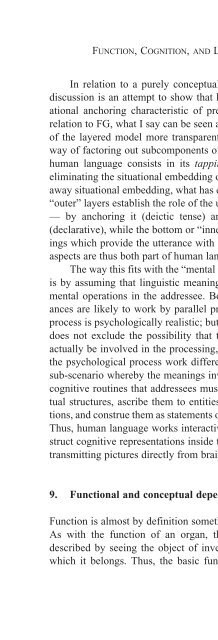Cognitive Semantics : Meaning and Cognition
Cognitive Semantics : Meaning and Cognition
Cognitive Semantics : Meaning and Cognition
You also want an ePaper? Increase the reach of your titles
YUMPU automatically turns print PDFs into web optimized ePapers that Google loves.
POLYSEMY AND DIFFERENTIATION IN THE LEXICON 123<br />
Han hade strukit i gränden utanför He had been prowling around in the<br />
Martinas hus. alley outside Martina’s house.<br />
There are also many clear examples of of resultative strengthening, for example,:<br />
Han strök av h<strong>and</strong>en på byxbaken, He wiped his h<strong>and</strong> off on his pant-leg.<br />
When certain types of nouns function as object, a specific instrument <strong>and</strong> a<br />
specific result is understood. A sentence such as Per strök taket means ‘Per<br />
painted the ceiling’, while Per strök sina byxor means ‘Per ironed his pants’.<br />
The instruments in these examples are BRUSH(x) <strong>and</strong> IRON(x), respectively.<br />
Any object that could naturally be interpreted as a surface that is conventionally<br />
painted or a cloth that is usually ironed will strongly suggest these specific<br />
meanings. The latter meaning can also be implied when there is no overt<br />
object:<br />
Det fattades smör, tvålen var slut, There wasn’t any butter, we’d run out of<br />
hon hade inte tänkt på att stryka. soap, she had forgotten to do the ironing.<br />
A further possibility is that the object refers to a word or an utterance,<br />
TEXT(y), for short. In this case, the instrument PEN(x) is understood: Peter<br />
strök under ordet (‘under the word’) ‘Peter underlined the word’ or Peter<br />
strök över (‘over’) ordet ‘Peter crossed out the word’. The semantic representation<br />
is shown in Table 13.<br />
The drawing (‘stroking’) of a pen over a piece of paper causes a line to<br />
exist. In addition, the line has a symbolic function, which shifts depending on<br />
its position with respect to the text. A line under the words signals importance,<br />
whereas a line through the words means that the text is not valid:<br />
Han fick fram en penna ur He slipped a pencil from his pocket <strong>and</strong><br />
bröstfickan och satte igång att stryka began underlining phrases.<br />
under diverse meningar.<br />
Då skulle han ha strukit över He’d have scratched out some names,<br />
vissa namn och satt in <strong>and</strong>ra i stället inserted others, <strong>and</strong> scrawled notes<br />
och gjort anteckningar i marginalen. across the margins.















